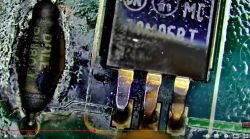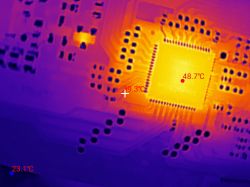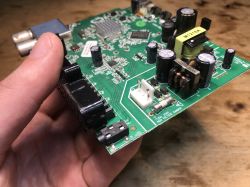In recent days, an interesting story of a certain repair has played out on the channel of the US-based service NorthridgeFix, which is based in Los Angeles.
Its author, Alex, regularly posts videos in which he demonstrates live the process of diagnosing and repairing damaged electronics. These videos are both educational and entertaining, documenting various cases involving the servicing of various devices.
This story is about the repair of a de-icing control module (De-Ice Circuit Board) from a $10 million Cessna Citation 560 aircraft. Alex received the board for repair with a faulty voltage regulator and a faulty resistor.
These are a 78M05 linear stabiliser and a 20 ƒ DALE resistor.

In the absence of service diagrams, he had to work out the value of the burnt resistor by enlarging a photo of the same board, which someone was selling on eBay for $12,000.
In the posted video, he demonstrated replacing the regulator and resistor, using a variety of professional techniques and tools for doing so.
He showed this in his first material, after whose publication he was met with a wave of criticism in the comments, accusing him of not being able to work on aerospace parts without FAA (Federal Aviation Administration) certification.
Noteworthy are the close-up photos of the electronics, where you can see what quality components are used in aviation, what the PCB looks like and how the author approached the purchase of parts (although he is not a certified Cessna electronics service technician, it is not everyone's cup of tea to buy a stabiliser for tens or hundreds of zloty). Also of interest is the damage on the board, including the burnt out laminate and how it was repaired (not sure if it complies or not with FAA standards). It looks as if the integrated voltage regulator failed, then a resistor acted as a fuse, but this is only one possible scenario.
Alex dispelled the myth surrounding allegations of working on aircraft electronics, explaining in the second video that anyone can physically repair such a board (even the aircraft owner), but the board absolutely cannot return to the aircraft until it has been inspected, tested and approved (signed off) by an FAA/EASA certified repairer or technician. This is the ultimate legal responsibility.
Alex completed the repair of the second component (resistor and voltage stabiliser), taking meticulous measurements, and then sent the board back to the customer, who is required to have it air certified.
This was followed by another video, perhaps the most surprising of all - it includes an account of a visit by three inspectors from the US FAA to his workshop
The inspectors visited to verify where the module from the Cessna he was repairing had come from, and to ensure that the part would not go back into the aircraft without proper certification.
The author received confirmation that, as a non-certified FAA technician, he was permitted to repair such motherboards. The key rule is that a repaired panel cannot be fitted to an aircraft without being signed off and certified by a qualified FAA technician.
The inspectors insisted that the workshop owner give them the name of the company or person who sent them the plate for repair, as they wanted to investigate whether this entity was selling uncertified parts as fully operational and safe. The workshop owner refused to disclose customer data, explaining that this is private information and its role is limited to repairs, not to check the legitimacy of the customer's business.
The FAA has expressed concern that people are prepared to risk the safety of expensive aircraft ($10 million) and people by buying uncertified parts for $2000-$3000, rather than certified ones for $15000-$20000.
Its author, Alex, regularly posts videos in which he demonstrates live the process of diagnosing and repairing damaged electronics. These videos are both educational and entertaining, documenting various cases involving the servicing of various devices.
This story is about the repair of a de-icing control module (De-Ice Circuit Board) from a $10 million Cessna Citation 560 aircraft. Alex received the board for repair with a faulty voltage regulator and a faulty resistor.
These are a 78M05 linear stabiliser and a 20 ƒ DALE resistor.

In the absence of service diagrams, he had to work out the value of the burnt resistor by enlarging a photo of the same board, which someone was selling on eBay for $12,000.
In the posted video, he demonstrated replacing the regulator and resistor, using a variety of professional techniques and tools for doing so.
He showed this in his first material, after whose publication he was met with a wave of criticism in the comments, accusing him of not being able to work on aerospace parts without FAA (Federal Aviation Administration) certification.
Noteworthy are the close-up photos of the electronics, where you can see what quality components are used in aviation, what the PCB looks like and how the author approached the purchase of parts (although he is not a certified Cessna electronics service technician, it is not everyone's cup of tea to buy a stabiliser for tens or hundreds of zloty). Also of interest is the damage on the board, including the burnt out laminate and how it was repaired (not sure if it complies or not with FAA standards). It looks as if the integrated voltage regulator failed, then a resistor acted as a fuse, but this is only one possible scenario.
Alex dispelled the myth surrounding allegations of working on aircraft electronics, explaining in the second video that anyone can physically repair such a board (even the aircraft owner), but the board absolutely cannot return to the aircraft until it has been inspected, tested and approved (signed off) by an FAA/EASA certified repairer or technician. This is the ultimate legal responsibility.
Alex completed the repair of the second component (resistor and voltage stabiliser), taking meticulous measurements, and then sent the board back to the customer, who is required to have it air certified.
This was followed by another video, perhaps the most surprising of all - it includes an account of a visit by three inspectors from the US FAA to his workshop
The inspectors visited to verify where the module from the Cessna he was repairing had come from, and to ensure that the part would not go back into the aircraft without proper certification.
The author received confirmation that, as a non-certified FAA technician, he was permitted to repair such motherboards. The key rule is that a repaired panel cannot be fitted to an aircraft without being signed off and certified by a qualified FAA technician.
The inspectors insisted that the workshop owner give them the name of the company or person who sent them the plate for repair, as they wanted to investigate whether this entity was selling uncertified parts as fully operational and safe. The workshop owner refused to disclose customer data, explaining that this is private information and its role is limited to repairs, not to check the legitimacy of the customer's business.
The FAA has expressed concern that people are prepared to risk the safety of expensive aircraft ($10 million) and people by buying uncertified parts for $2000-$3000, rather than certified ones for $15000-$20000.
Cool? Ranking DIY Helpful post? Buy me a coffee.





